Publisher's Synopsis
English summary: The gold objects derive from the excavations carried out between 1965 and 1994 in the Artemision of Ephesos by the Austrian Archaeological Institute. Most of the objects occurred in strata located under the Archaic kipteros and may thus be classified as originating from the second half of the seventh or the first half of the sixth century BC. They were deposited in the sanctuary as votive gifts. The vast majority are dress ornaments and jewellery, either worn directly on the body or sewn onto clothing such as appliques or pieces of sheet gold decorated with a variety of motives, spherical and drop-shaped pendants and beads (some of which look like fruit), pins with floral heads, fibulae (predominantly of Phrygian 'Asia Minor' type), brooches in the shape of birds of prey and boat-shaped earrings with, in some cases, elaborate decoration. There are also some figurines which are definitely worth of note such as anthropomorphic and zoomorphic statuettes. The Artemision is unique in the Archaic period with regard to the amount and variety of gold jewellery found there: No other sanctuary from this period has yielded a similar wealth of gold objects. By including an examination of most of the gold objects from the English excavations in the sanctuary (1904/05) it has been possible to add to the amount and variety of gold jewellery known to have exited. Published with funding from the Austrian Science Fund. German description: Aus den Grabungen 1965 bis 1994 im Artemision von Ephesos durch das Osterreichische Archaologische Institut (Leitung: A. Bammer) stammen 703 Goldobjekte, die als Votivgaben im Heiligtum niedergelegt wurden. Sie sind zeitlich in die zweite Halfte des 7. bis in die erste Halfte des 6. Jahrhunderts v. Chr. einzuordnen. Den grossten Prozentsatz machen Trachtzubehor und Schmuckstucke aus, die sich in direkt am Korper getragenem oder aber an der Kleidung o. a. befestigtem Schmuck einteilen lassen. Es uberwiegen Appliken oder Plattchen mit unterschiedlichen Motiven, schiffchenformige Ohrringe, teilweise mit zusatzlichen Verzierungen, kugel- und tropfenformige Anhanger und Perlen, die mitunter an Fruchte erinnern, Nadeln mit blutenartigen Kopfen, Fibeln, die hauptsachlich dem phrygischen "Asia Minor"-Typus entsprechen, "raubvogelformige" Broschen sowie einige figurliche Objekte (anthropo- und zoomorphe Statuetten). Die vielfaltigen Formen und Motive der vorgestellten Goldobjekte beziehen sich grossteils auf bestimmte Kategorien der Fauna und Flora, die mit der hier verehrten Gottheit in Verbindung gebracht werden konnen. Die Vielzahl und -falt an Goldschmuck aus dem Artemision der archaischen Epoche ist einzigartig, gibt es doch kein anderes zeitgleiches Heiligtum mit einer vergleichbaren Funddichte an Goldobjekten. Durch das Einbeziehen der Funde aus den englischen Grabungen im Heiligtum (1904/05) in die Auswertung und Interpretation konnte das Formenspektrum deutlich erweitert und die damit verbundenen Fragestellungen wie die Bedeutung der Goldfunde fur den Kult konkretisiert werden. Gedruckt mit Unterstutzung des Fonds zur Forderung der wissenschaftlichen Forschung










